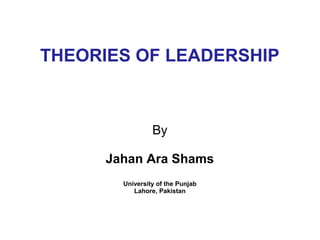
Theories of Leadership
- 1. THEORIES OF LEADERSHIP By Jahan Ara Shams University of the Punjab Lahore, Pakistan
- 2. Theory X & Theory Y People are inherently People are not lazy and dislike work inherently lazy and like work People must be coerced, controlled, People will exercise directed and self-direction and self- threatened control to reach organizational goals
- 3. The Ohio State Studies Ohio State researchers at Ohio State University found that leaders behavior could be described in terms of two dimensions – Initiating Structure – Consideration
- 4. The Michigan Studies By Resis Likert and his associates at the University of Michigan How leadership behavior relates to organizational performance Identified two leader behaviors – Employee-centered leader behavior – Job-centered leader behavior
- 5. Rensis Likert identified four main styles of leadership, in particular around decision-making and the degree to which people are involved in the decision. • Exploitive authoritative In this style, the leader has a low concern for people and uses such methods as threats and other fear- based methods to achieve conformance. Communication is almost entirely downwards and the psychologically distant concerns of people are ignored. • Benevolent authoritative When the leader adds concern for people to an authoritative position, a 'benevolent dictatorship' is formed. The leader now uses rewards to encourage appropriate performance and listens.
- 6. • Consultative The upward flow of information here is still cautious and rose-tinted to some degree, although the leader is making genuine efforts to listen carefully to ideas. Nevertheless, major decisions are still largely centrally made. • Participative At this level, the leader makes maximum use of participative methods, engaging people lower down the organization in decision-making. People across the organization are psychologically closer together and work well together at all levels. "Our knowledge can only be finite, while our ignorance must necessarily be infinite." ― Karl Popper, Austrian philosopher
- 7. Blake and Mouton's Managerial Grid By Robert R. Blake and Jane Srygley Mouton Method of analyzing leader behavior using a two-dimensional grid Concern for people Concern for production
- 8. Hersey & Blanchard Theory of Leadership Developed by Paul Hersey and Kenneth H. Blanchard States that the leader's behavior (task behavior/ relationship behavior) should be altered according to the employees readiness/maturity (ability and willingness ) to complete the task States that behaviors (high or low) determine the leadership style and leadership style is contingent on followers maturity level (able/unable and willing/unwilling).
- 9. Four Leadership Styles Telling Leadership High Task + Low Relationship......Directing Leadership Selling Leadership High Task + High Relationship.....Couching Leadership Participating Leadership Low Task + High Relationship......Supporting Leadership Delegating Leadership Low Task + Low Relationship.......Delegating Leadership
- 10. Path Goal theory of Leadership By Martin G. Evans, Robert J. House and others It has its roots in expectancy theory of motivation Suggests that the leader's primary motivational functions are to make attractive rewards available, to guide employees through the path to these rewards by clarifying the behavior that will achieve goals, and to remove any obstacles that prevent goal attainment. Suggests leaders can modify their behavior depending on the situational variables (environmental factors,subordinate characteristics ) they face.
- 11. Four Behaviors of a Leader Directive Leadership- task is unstructured, complex or novel or subordinates lack skills........telling exactly what to do and how to do........similar initiating structure and task orientation Supportive Leadership -task unambiguous, boring or stressful........to increase satisfaction of your subordinates........similar to consideration and relationship orientation.
- 12. Achievement Oriented Leadership task unstructured.........challenging followers so as to increase their self-confidence and satisfaction. Participative Leadership task unstructured.............................................call for participation....consulting.
- 13. FIEDLER'S CONTINGENCY THEORY It relates situation favorability (Leader-member relations, Task structure, Position Power) towards various leadership styles to help leaders determine the best approach in a given situation. > > Relationship motivated behavior >> Task motivated behavior
- 14. Transformational theory of Leadership James MacGregor Burns (1978) first introduced the concept of transforming leadership in his descriptive research on political leaders, but this term is now used in organizational psychology as well. According to Burns, transforming leadership is a process in which "leaders and followers help each other to advance to a higher level of morale and motivation". Bernard M. Bass (1985), extended the work of Burns (1978) and introduced the term "transformational" in place of "transforming. He said that the extent to which a leader is transformational, is measured first, in terms of his influence on the followers.
- 15. Four basic elements of transformational leadership: Individualized Consideration – the degree to which the leader attends to each follower's needs, acts as a mentor or coach to the follower and listens to the follower's concerns and needs. The leader gives empathy and support, keeps communication open and places challenges before the followers. Intellectual Stimulation – the degree to which the leader challenges assumptions, takes risks and solicits followers' ideas. Leaders with this style stimulate and encourage creativity in their followers. They nurture and develop people who think independently. Inspirational Motivation – the degree to which the leader articulates a vision that is appealing and inspiring to followers. Leaders with inspirational motivation challenge followers with high standards, communicate optimism about future goals, and provide meaning for the task at hand. The followers are willing to invest more effort in their tasks, they are encouraged and optimistic about the future and believe in their abilities. Idealized Influence – Provides a role model for high ethical behavior, instills pride, gains respect and trust.